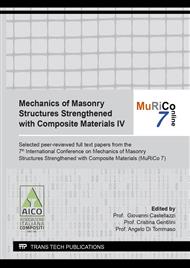p.91
p.98
p.105
p.115
p.123
p.130
p.136
p.147
p.155
Crystallization from Sodium Sulphate Solution Confined in Red Clay Brick during Temperature Decrease
Abstract:
Water with dissolved contaminations is a frequent problem faced in porous building materials such as masonry, or cement-based composites. It regards both contemporary constructions, and those belonging to the cultural heritage. Among soluble salts, sodium sulfate is recognized as one of the most dangerous one. Since crystals of Na2SO4 can occur in the variety of forms, its crystallization in pores of a building material is a challenging and not fully recognized issue. The main object of the presented research is to identify the consecutive phase transitions occurring within red clay brick containing sodium sulphate solution during cooling. The first stage of an experimental investigation was performed by means of mercury intrusion porosimetry to verify whether cyclic crystallization has a damaging effect on material microstructure. In the second step of experimental analysis differential scanning calorimetry was applied. The technique was used to monitor the crystallization of sodium sulphate confined in samples during repeating cooling-heating cycles covering temperature range from -20°C to 40°C. It was observed that during primary crystallization, sodium sulfate heptahydrate is the first precipitating phase and the transition begins far below its equilibrium temperature. Subsequently, the heptahydrate transforms into mirabilite, which probably induced rapid ice crystallization. Nevertheless, if decahydrate nuclei are provided in pore solution, sodium sulphate precipitates directly as mirabilite with no heptahydrate formation. Such a pattern is observed for both analysed solution concentration, i.e. 25% and 30%.
Info:
Periodical:
Pages:
123-129
Citation:
Online since:
April 2022
Authors:
Price:
Сopyright:
© 2022 Trans Tech Publications Ltd. All Rights Reserved
Share:
Citation:


